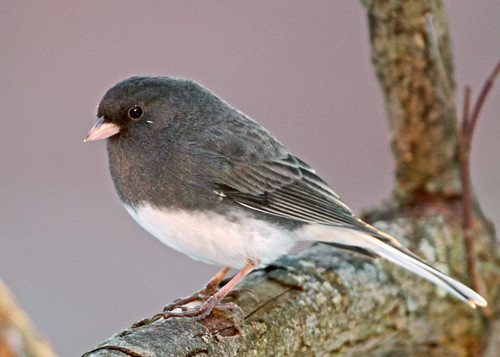 As we look forward to spring with great anticipation, it's good to remember the junco -- who thinks our winters are balmy. Juncos generally breed further north, coming down to the DC area from about October through mid-March to enjoy our milder weather. Based on reports of the bird from Virginia, early taxonomists gave it the Latin name Junco hyemalis, or winter junco. We have to wonder what Canadians think of that.
As we look forward to spring with great anticipation, it's good to remember the junco -- who thinks our winters are balmy. Juncos generally breed further north, coming down to the DC area from about October through mid-March to enjoy our milder weather. Based on reports of the bird from Virginia, early taxonomists gave it the Latin name Junco hyemalis, or winter junco. We have to wonder what Canadians think of that.Actually, Junco hyemalis is more often referred to as the Dark-eyed Junco, perhaps as a nod to our friends in the north. In addition to their dark eyes, juncos have a white belly and a light-colored pinkish beak that stand out against their otherwise slate-grey body. They've also got white in their outer tailfeathers, which you may notice especially when they're in flight. That white gives the junco some camouflage in the snow. They may not need it so much here, but their winter range includes places as cold as the Dakotas -- which still beats spending the winter in northern Saskatchewan.
 Wherever they are, juncos generally hang out on the ground -- they even nest on the ground most of the time (though not until they get to their summer homes). Their plumage is well designed for this habitat and often makes them hard to see. So, it can be helpful to keep an ear out for their songs and calls. They make several different trills and chipping noises. Examples of both are here and here.
Wherever they are, juncos generally hang out on the ground -- they even nest on the ground most of the time (though not until they get to their summer homes). Their plumage is well designed for this habitat and often makes them hard to see. So, it can be helpful to keep an ear out for their songs and calls. They make several different trills and chipping noises. Examples of both are here and here.In the wild: Look on especially on forest floors as you're hiking, but in the winter juncos can also be in fields and roadsides as they forage for food. Keep an eye out for them hopping around and pecking in the leaf litter, or flying into the underbrush to get away from you.
 In your yard: About three quarters of a junco's diet comes from seeds. That makes it a good chance that you'll see them at a birdfeeder -- or, even more likely, foraging among the seeds that have spilled onto the ground. Without a birdfeeder, we've seen them foraging on the ground in our yard in the leaf litter, but not very frequently.
In your yard: About three quarters of a junco's diet comes from seeds. That makes it a good chance that you'll see them at a birdfeeder -- or, even more likely, foraging among the seeds that have spilled onto the ground. Without a birdfeeder, we've seen them foraging on the ground in our yard in the leaf litter, but not very frequently.Any other tips for spotting juncos? Have you seen any recently? Let us know!
Like the photos in this post? Mouse over for credits; a click takes you to the photographer on Flickr.


